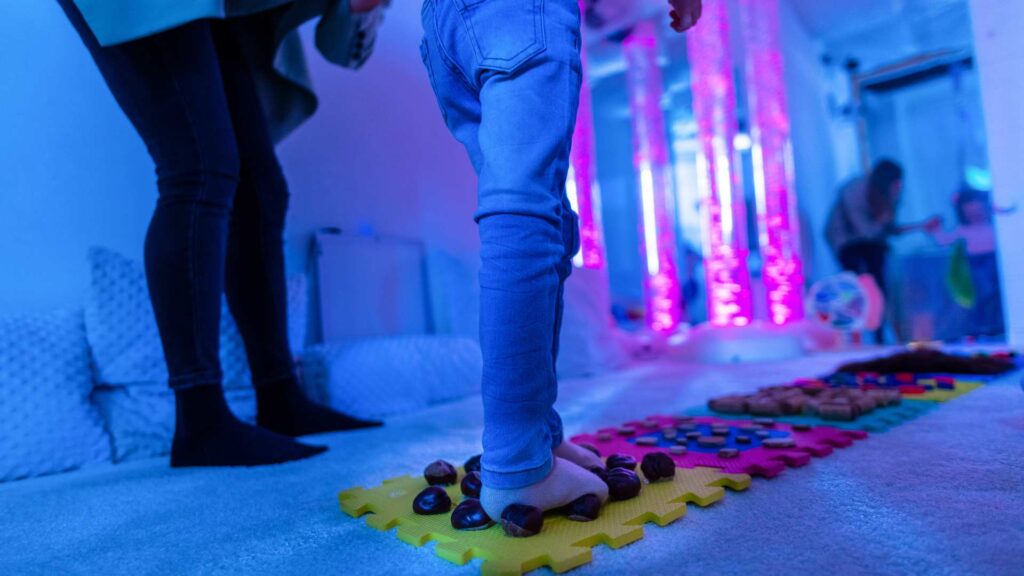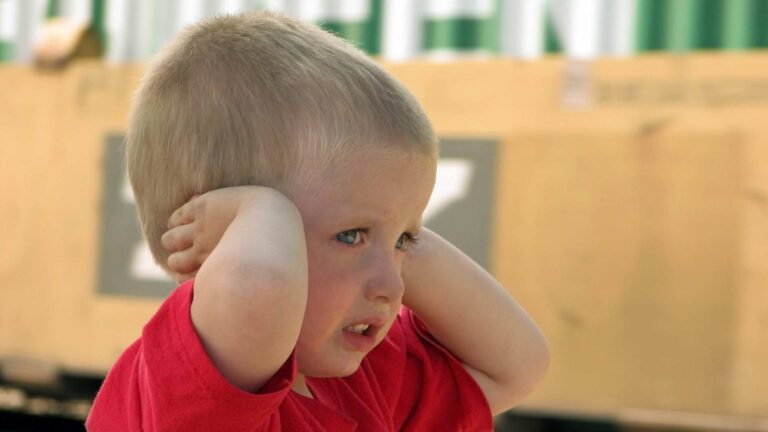Tabla de contenidos
¿Cuál trastorno del procesamiento está asociado con el autismo?
Navegar por el trastorno del espectro autista (TEA) es comprender que muchas cosas se correlacionarán con el comportamiento y el desarrollo de tu hijo más allá del mero autismo. Por ejemplo, muchas veces, el TEA se superpone con otras afecciones como el TOC, la ansiedad, el TDAH y otras, incluido el trastorno del procesamiento sensorial (TPS). Sin embargo, saber cómo identificar los desafíos sensoriales y el autismo te permitirá aprender estrategias para marcar una diferencia significativa en su desarrollo y bienestar.
El trastorno del procesamiento sensorial y el autismo están estrechamente relacionados, pero son condiciones distintas. Si bien muchas personas con autismo experimentan sensibilidades sensoriales, el TPS también puede existir independientemente del autismo.
Sabemos que esta superposición a menudo conduce a la confusión de los padres, que se preguntan si los comportamientos de sus hijos se derivan del TPS, el autismo o una combinación de ambos. Por eso, en este blog de ABA Centers of Florida, te explicaremos estas diferencias y exploraremos estrategias prácticas, incluida la terapia ABA.
¿Qué es el Trastorno del Procesamiento Sensorial?
Según la Child Mind Institute, el trastorno del procesamiento sensorial ocurre cuando el cerebro tiene dificultades para recibir, interpretar y responder adecuadamente a la información sensorial. Esta afección puede afectar a uno o varios sentidos, como el tacto, el oído, el gusto o la vista. Los niños con TPS pueden ser demasiado sensibles a los estímulos (hipersensibilidad) o no responder bien a los estímulos sensoriales (hiposensibilidad).
Por ejemplo, un niño con hipersensibilidad puede encontrar insoportables los ruidos fuertes, no le gustan ciertas texturas de ropa o evita las luces brillantes. Por otro lado, un niño con hiposensibilidad puede buscar el movimiento constante, tener dificultades para reconocer el dolor o anhelar experiencias sensoriales intensas.

Es importante tener en cuenta que el TPS no está clasificado ni reconocido oficialmente como un trastorno en muchos manuales de diagnóstico.
Trastorno del Procesamiento Sensorial y el Autismo
Las sensibilidades sensoriales son comunes en los niños con autismo, e incluso forman parte de los criterios diagnósticos, pero no todos los niños con TPS tienen autismo. Las investigaciones indican que una parte significativa de las personas con autismo también experimentan dificultades de procesamiento sensorial. De hecho, según Frontiers in Psychiatry, el 90% de las personas con autismo demuestran desafíos sensoriales en cierta medida.
Sin embargo, la diferencia clave radica en las características más amplias de cada uno. Mientras que el TPS se centra específicamente en los desafíos sensoriales, el autismo abarca una variedad de diferencias sociales, de comunicación y de comportamiento. Un niño con Trastorno del Procesamiento Sensorial puede tener dificultades para manejar la información sensorial, pero es posible que no muestre los desafíos de comunicación o las diferencias sociales que se observan típicamente en el autismo. Por el contrario, un niño con autismo puede experimentar dificultades sensoriales junto con desafíos con la interacción social, comportamientos repetitivos y regulación emocional.
Rasgos del Procesamiento Sensorial en el Autismo

Como ya hemos mencionado, el TPS puede ocurrir de forma individual y también puede formar parte del autismo. Sin embargo, si eres padre o cuidador, detectar estos rasgos puede ser un paso esencial para comprender y apoyar mejor a tu hijo. Estos son algunos signos comunes de TPS en niños con autismo a los que se debe prestar atención:
- Sensibilidad extrema o falta de sensibilidad al tacto, al gusto, al sonido, a la vista o al olfato
- Tener dificultades con los cambios en las rutinas o la transición entre actividades
- Buscar información sensorial, como tocar todo o anhelar experiencias sensoriales intensas
- Evitar ciertas texturas, sonidos o ambientes que los abrumen.
- Problemas con las habilidades motoras finas, como escribir o atarse los zapatos
- Encontrar las interacciones sociales y la regulación emocional difíciles de manejar
- Ser impulsivo o demasiado activo
- Problemas para concentrarse o mantener la atención
- Problemas para dormir, incluyendo dificultades para conciliar el sueño o permanecer dormido
Cómo se Evalúan las Dificultades del Procesamiento Sensorial
Aunque el TPS no tiene criterios de diagnóstico oficiales, eso no significa que los profesionales no puedan abordarlo. Los profesionales médicos, particularmente aquellos con experiencia en el apoyo al autismo, pueden evaluar las necesidades sensoriales de tu hijo a través de evaluaciones. Las sensibilidades sensoriales ya forman parte del marco de diagnóstico del autismo, por lo que es algo que los médicos saben cómo apoyar.
Consejos Para los Padres que Atraviesan las Dificultades del Procesamiento Sensorial
Apoyar a un niño con autismo y desafíos sensoriales puede resultar abrumador a veces. Aunque se trate de autismo o trastorno del procesamiento sensorial, saber cómo apoyar a tu hijo realmente puede hacer que la vida cotidiana sea más fácil y agradable para ambos. Aquí hay siete estrategias prácticas que pueden ayudarte y guiarte:
1. Celebra la Individualidad
Cada experiencia sensorial es diferente. Adáptate a las respuestas únicas de tu hijo al mundo y comprende qué funciona mejor para él. No existe un enfoque único para todos, así que ten paciencia y curiosidad por sus necesidades. Por ejemplo, si a tu hijo le irritan los ruidos fuertes, como una aspiradora, intenta usar auriculares con cancelación de ruido o cambia a un método de limpieza más silencioso.
2. Sigue Aprendiendo Sobre el TPS y las Sensibilidades Sensoriales
Edúcate a ti y a las personas que te rodean sobre el procesamiento sensorial. Cuando los maestros, la familia y los cuidadores comprenden los desafíos que enfrenta tu hijo, pueden ofrecer un mejor apoyo.
3. Anticipa el Cambio
Las sensibilidades sensoriales no siempre son predecibles. Tu hijo puede afrontar bien una situación un día, pero tener dificultades con la misma situación al día siguiente. Factores como el estrés, la fatiga o incluso el entorno juegan un papel importante.
4. Haz Ajustes Para Mayor Comodidad
Pequeños cambios pueden tener un impacto considerable. La ropa sensorialmente o un espacio acogedor para tomar descansos pueden hacer que las situaciones abrumadoras sean mucho más fáciles para tu hijo.
5. Crea un Hogar Sensorialmente Seguro
Piensa en maneras de hacer de tu hogar un ambiente donde tu hijo pueda prosperar. Suaviza la iluminación, mantén los espacios organizados y ten a mano juguetes inquietos o herramientas calmantes para ayudarlos a regularse.
6. No Tengas Miedo de Pedir Ayuda
El soporte profesional puede cambiarlo todo. Los terapeutas ocupacionales, los especialistas sensoriales o los terapeutas conductuales pueden ofrecer estrategias específicas para satisfacer las necesidades de tu hijo.
7. Enseña Habilidades de Autorregulación
Ayuda a tu hijo a aprender maneras de manejar su mundo sensorial. La respiración profunda, las herramientas sensoriales o aprender cuándo tomar un descanso pueden aumentar su confianza e independencia con el tiempo.
Abordando Pronto los Desafíos del Procesamiento Sensorial

Cuanto antes tu ser querido comience a recibir apoyo, mejor. La intervención durante la infancia puede marcar una diferencia significativa. La terapia puede ayudar a los niños a mejorar la regulación sensorial, desarrollar habilidades motoras e incluso agudizar su capacidad para socializar.
No existe un plan perfecto para todos los niños, pero trabajar junto a profesionales para desarrollar un enfoque personalizado puede marcar una gran diferencia. Estas son algunas terapias que se usan comúnmente:
Terapia Ocupacional: Se enfoca en desarrollar habilidades esenciales como vestirse, comer y participar en el juego.
Terapia de Integración Sensorial: Ayuda a los niños a adaptarse y tolerar diversas experiencias sensoriales a través de actividades específicas.
Terapia del Habla: utiliza técnicas como ayudas visuales o cuentos para ayudar a los niños a reconocer y responder mejor a los desencadenantes sensoriales.
Análisis del Comportamiento Aplicado (ABA): Enseña nuevas habilidades mientras aborda comportamientos desafiantes a través de estrategias de refuerzo positivo.
Apoyo de ABA Centers of Florida
En ABA Centers of Florida, tenemos una amplia experiencia en el apoyo a niños con autismo y desafíos del procesamiento sensorial. Nuestros programas personalizados de terapia ABA ayudan a abordar las necesidades únicas de cada niño, combinando estrategias basadas en evidencia con atención compasiva.
Además de ofrecer servicios integrales de diagnóstico de autismo e intervención temprana, brindamos terapia ABA personalizada a familias en Doral, Miramar, Jensen Beach, Tampa, Orlando, Boca Ratón, Melbourne, Davenport y Kissimmee. Al trabajar en estrecha colaboración con las familias, nuestros terapeutas dedicados ayudan a los niños a desarrollar habilidades esenciales, desarrollar una mayor independencia y prosperar en su vida diaria.
Si estás navegando por las complejidades del trastorno del procesamiento sensorial y el autismo, no estás solo. Con las estrategias y el apoyo adecuados, tu hijo puede desarrollar confianza y aprender a manejar su mundo sensorial con éxito. Llámanos al (877) 999-0258 o (772) 773-1975 o programa una consulta gratuita para explorar nuestros servicios de atención al autismo.








